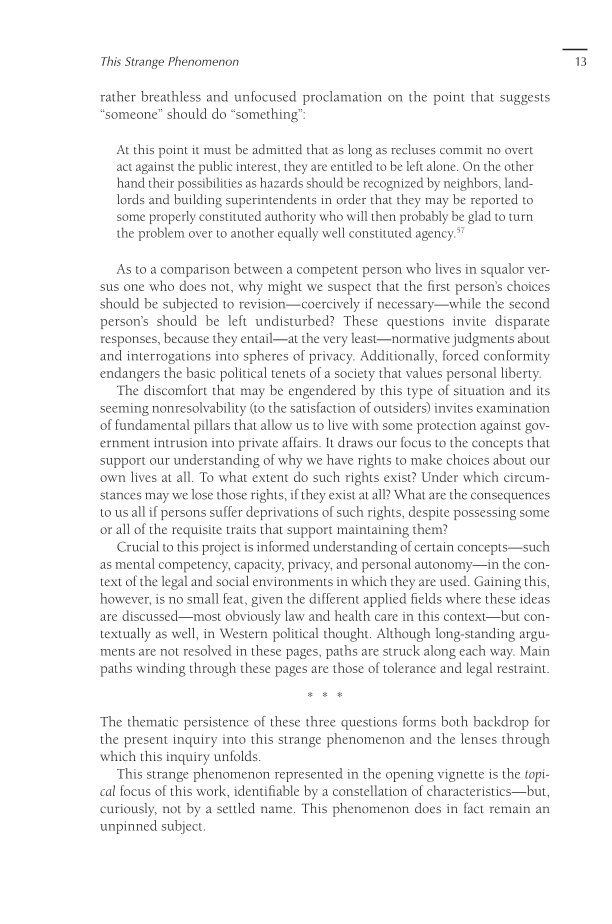This Strange Phenomenon 13 rather breathless and unfocused proclamation on the point that suggests “someone” should do “something”: At this point it must be admitted that as long as recluses commit no overt act against the public interest, they are entitled to be left alone. On the other hand their possibilities as hazards should be recognized by neighbors, land- lords and building superintendents in order that they may be reported to some properly constituted authority who will then probably be glad to turn the problem over to another equally well constituted agency.57 As to a comparison between a competent person who lives in squalor ver- sus one who does not, why might we suspect that the first person’s choices should be subjected to revision—coercively if necessary—while the second person’s should be left undisturbed? These questions invite disparate responses, because they entail—at the very least—normative judgments about and interrogations into spheres of privacy. Additionally, forced conformity endangers the basic political tenets of a society that values personal liberty. The discomfort that may be engendered by this type of situation and its seeming nonresolvability (to the satisfaction of outsiders) invites examination of fundamental pillars that allow us to live with some protection against gov- ernment intrusion into private affairs. It draws our focus to the concepts that support our understanding of why we have rights to make choices about our own lives at all. To what extent do such rights exist? Under which circum- stances may we lose those rights, if they exist at all? What are the consequences to us all if persons suffer deprivations of such rights, despite possessing some or all of the requisite traits that support maintaining them? Crucial to this project is informed understanding of certain concepts—such as mental competency, capacity, privacy, and personal autonomy—in the con- text of the legal and social environments in which they are used. Gaining this, however, is no small feat, given the different applied fields where these ideas are discussed—most obviously law and health care in this context—but con- textually as well, in Western political thought. Although long-standing argu- ments are not resolved in these pages, paths are struck along each way. Main paths winding through these pages are those of tolerance and legal restraint. * * * The thematic persistence of these three questions forms both backdrop for the present inquiry into this strange phenomenon and the lenses through which this inquiry unfolds. This strange phenomenon represented in the opening vignette is the topi- cal focus of this work, identifiable by a constellation of characteristics—but, curiously, not by a settled name. This phenomenon does in fact remain an unpinned subject.
Document Details My Account Print multiple pages
Print
You have printed 0 times in the last 24 hours.
Your print count will reset on at .
You may print 0 more time(s) before then.
You may print a maximum of 0 pages at a time.



















































































































































































































